Related Research Articles
The AIM-120 Advanced Medium-Range Air-to-Air Missile(AMRAAM) (pronounced AM-ram /æmɹæm/), is an American beyond-visual-range air-to-air missile capable of all-weather day-and-night operations. It uses active transmit-receive radar guidance instead of semi-active receive-only radar guidance. It is a fire-and-forget weapon, unlike the previous generation Sparrow missiles which required full guidance from the firing aircraft. When an AMRAAM missile is launched, NATO pilots use the brevity code "Fox Three".

The AIM-54 Phoenix is an American radar-guided, long-range air-to-air missile (AAM), carried in clusters of up to six missiles on the Grumman F-14 Tomcat, its only operational launch platform.
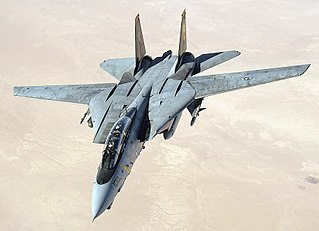
The Grumman F-14 Tomcat is an American carrier-capable supersonic, twin-engine, two-seat, twin-tail, all-weather-capable variable-sweep wing fighter aircraft. The Tomcat was developed for the United States Navy's Naval Fighter Experimental (VFX) program after the collapse of the General Dynamics-Grumman F-111B project. A large and well-equipped fighter, the F-14 was the first of the American Teen Series fighters, which were designed incorporating air combat experience against MiG fighters during the Vietnam War.
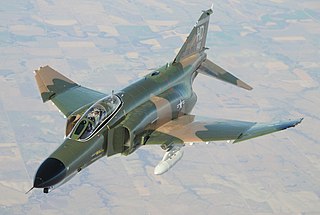
The McDonnell Douglas F-4 Phantom II is an American tandem two-seat, twin-engine, all-weather, long-range supersonic jet interceptor and fighter-bomber originally developed by McDonnell Aircraft for the United States Navy. Proving highly adaptable, it entered service with the Navy in 1961 before it was adopted by the United States Marine Corps and the United States Air Force, and by the mid-1960s it had become a major part of their air arms. Phantom production ran from 1958 to 1981 with a total of 5,195 aircraft built, making it the most produced American supersonic military aircraft in history, and cementing its position as a signature combat aircraft of the Cold War.
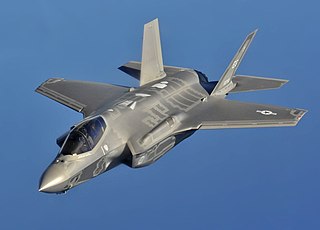
The Lockheed Martin F-35 Lightning II is an American family of single-seat, single-engine, all-weather stealth multirole combat aircraft that is intended to perform both air superiority and strike missions. It is also able to provide electronic warfare and intelligence, surveillance, and reconnaissance capabilities. Lockheed Martin is the prime F-35 contractor, with principal partners Northrop Grumman and BAE Systems. The aircraft has three main variants: the conventional takeoff and landing (CTOL) F-35A, the short take-off and vertical-landing (STOVL) F-35B, and the carrier-based (CV/CATOBAR) F-35C.

The Lockheed Martin/Boeing F-22 Raptor is an American single-seat, twin-engine, supersonic all-weather stealth fighter aircraft developed for the United States Air Force (USAF). As a product of the USAF's Advanced Tactical Fighter (ATF) program the aircraft was designed as an air superiority fighter, but also incorporates ground attack, electronic warfare, and signals intelligence capabilities. The prime contractor, Lockheed Martin, built most of the F-22's airframe and weapons systems and conducted final assembly, while program partner Boeing provided the wings, aft fuselage, avionics integration, and training systems.
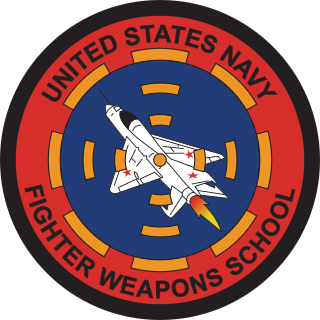
The United States Navy Strike Fighter Tactics Instructor program, more popularly known as Top Gun, is a United States Navy training program that teaches air combat maneuvering tactics and techniques to selected naval aviators and naval flight officers, who return to their operating units as surrogate instructors.

Strike Fighter Squadron 32 (VFA-32), nicknamed the "Fighting Swordsmen" are a United States Navy strike fighter squadron presently flying the F/A-18F Super Hornet and based ashore at Naval Air Station Oceana. Their radio callsign is Gypsy and their tail code is AC. The Fighting Swordsmen of VFA-32 are the 2023 recipients of the Mutha Fighter Spirit Award, awarded annually at the Navy’s Strike Fighter Ball in Norfolk, VA.

William Patrick "Willy Irish" Driscoll is a retired commander in the United States Navy and a flying ace. Driscoll, a Naval Flight Officer, and aircrewmate Duke Cunningham, a Naval Aviator, were their service's only aces of the Vietnam War. They remain the Navy's most recently minted aces.
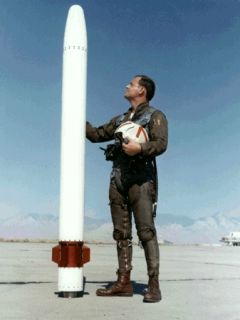
The AIM-95 Agile was an air-to-air missile developed by the United States. It was developed by the US Navy to equip the F-14 Tomcat, replacing the AIM-9 Sidewinder. Around the same time, the US Air Force was designing the AIM-82 to equip their F-15 Eagle, and later dropped their efforts to join the Agile program. In the end, newer versions of Sidewinder would close the performance gap so much that the Agile program was canceled.

The Naval Aviation Warfighting Development Center was formerly known as the Naval Strike and Air Warfare Center at Naval Air Station Fallon located in the city of Fallon in western Nevada. It is the center of excellence for naval aviation training and tactics development. NAWDC provides service to aircrews, squadrons and air wings throughout the United States Navy through flight training, academic instructional classes, and direct operational and intelligence support. The name was changed from NSAWC to NAWDC in June 2015 to align with the naming convention of the Navy's other Warfighting Development Centers (including Naval Surface and Mine Warfighting Development Center, Naval Information Warfighting Development Center, and the Undersea Warfighting Development Center.
VFAX for Naval Fighter Attack Experimental was actually two specifications for two US Navy fighter projects. The first was for a low cost lightweight complement for the General Dynamics–Grumman F-111B which could replace the McDonnell F-4 Phantom II for air superiority, escort, and ground attack missions in the early 1960s. This role was dropped in favor of the VFX aircraft, which emerged as the F-14 Tomcat. The second VFAX evolved when the VFX proved too costly to replace all existing USN fighters and attack aircraft, and the Navy was invited to take part in the USAFs Lightweight Fighter Program (LWF). The Navy chose the YF-17, the loser of the LWF contest as its Navy Air Combat Fighter, as it was inherently more suitable to naval operations than the winning General Dynamics F-16 Fighting Falcon; it was redesigned to become the McDonnell Douglas F/A-18 Hornet.

Dissimilar air combat training (DACT) was introduced as a formal part of US air combat training after disappointing aerial combat exchange rates in the Vietnam War.
Captain Frank Ault, USN (Ret) was a United States Naval officer. He is best remembered for the classified study he led in 1968 that led to the creation of the Navy Fighter Weapons School, or TOPGUN. Disturbed over less than expected performance of Navy fighters against the North Vietnamese MiGs in the first stage of the Vietnam War 1965-1968 in which the exchange ratio was at best 2.5:1, Ault was directed by Adm. Tom Moorer, the Chief of Naval Operations (CNO) to conduct a sweeping review of aircraft, aircrew, organizational, training and missile performance and make recommendations for improvements. The official title of the report was Air-to-Air Missile System Capability Review, but it quickly became known simply as the Ault Report. Ault Field located at NAS Whidbey Island in Oak Harbor, WA is not named for him, rather, it is named for the Lexington's Air Group Commander who died at the battle of Coral Sea in 1942. Ironically, Frank Ault would command the carrier that bore the name of that battle, (CVA-43). The auditorium at NAS Fallon Nevada Naval Strike and Air Warfare Center is named for Captain Frank Ault.
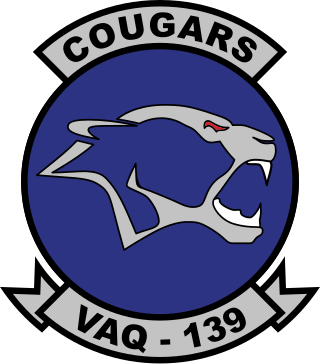
Electromagnetic Attack Squadron 139 (VAQ-139), also known as the "Cougars", is an EA-18G Growler squadron of the United States Navy. They specialize in electromagnetic attack and are currently stationed at Naval Air Station Whidbey Island, Washington. Part of Carrier Air Wing Seventeen, the Cougars deploy aboard the aircraft carrier USS Nimitz

The Operational Test and Evaluation Force (OPTEVFOR) is an independent and objective agency within the United States Navy for the operational testing and evaluation (OT&E) of naval aviation, surface warfare, submarine warfare, C4I, cryptologic, and space systems in support Navy and Department of Defense acquisition programs.

The AIM-9 Sidewinder is a short-range air-to-air missile. Entering service with the United States Navy in 1956 and the Air Force in 1964, the AIM-9 is one of the oldest, cheapest, and most successful air-to-air missiles. Its latest variants remain standard equipment in most Western-aligned air forces. The Soviet K-13, a reverse-engineered copy of the AIM-9B, was also widely adopted.

A squadron in an air force, or naval or army aviation service, is a unit comprising a number of military aircraft and their aircrews, usually of the same type, typically with 12 to 24 aircraft, sometimes divided into three or four flights, depending on aircraft type and air force.
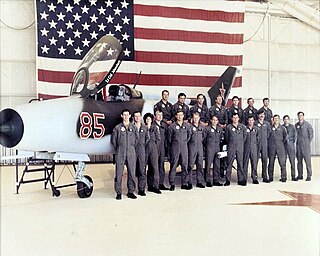
The 4477th Test and Evaluation Squadron was a squadron in the United States Air Force under the claimancy of the Tactical Air Command (TAC). It is currently inactive. The product of Project Constant Peg, the unit was created to expose the tactical air forces to the flight characteristics of fighter aircraft used by the Soviet Union during the Cold War. The declassified history of the squadron shows that it operated MiG-17s, MiG-21s and MiG-23s between 1977 and 1988, but it was not formally disbanded until July 1990.
Dan Pedersen is a retired United States Navy Captain, credited as being the leading force behind the creation of the United States Navy Fighter Weapons School program known as “TOPGUN”.
References
- 1 2 Polmar, Norman; Marolda, Edward (2015). Naval Air War The Rolling Thunder Campaign. Naval History and Heritage Command. ISBN 978-0945274827.
 This article incorporates text from this source, which is in the public domain .
This article incorporates text from this source, which is in the public domain . - ↑ David Baranek (September 2019). "Topgun: The Navy's first center of excellence". U.S. Naval Institute. Retrieved 13 July 2021.
- ↑ Michel III, Marshall (1997). Clashes, Air Combat Over North Vietnam 1965-1972. Naval Institute Press. pp. 156, 286–7. ISBN 9781591145196.
- ↑ Friedman, Norman (1989). The Naval Institute Guide to World Naval Weapon Systems. Naval Institute Press. p. 439. ISBN 9781557502629.
- ↑ Futrell, Frank (1976). United States Air Force in Southeast Asia 1965-1973: Aces and Aerial Victories (PDF). Air University, Headquarters USAF. p. 10.
 This article incorporates text from this source, which is in the public domain .
This article incorporates text from this source, which is in the public domain . - 1 2 3 4 5 "Report of the air-to-air missile system capability review July-November 1968" (PDF). Naval Air Systems Command. 1 January 1969. Retrieved 13 July 2021.
 This article incorporates text from this source, which is in the public domain .
This article incorporates text from this source, which is in the public domain . - ↑ Linder, Bruce (2001). San Diego's Navy. Annapolis, Maryland: Naval Institute Press. p. 156. ISBN 1-55750-531-4.
- 1 2 3 4 "Report of the air-to-air missile system capability review July-November 1968 Appendix IV" (PDF). Naval Air Systems Command. 1 January 1969. Retrieved 13 July 2021.
 This article incorporates text from this source, which is in the public domain .
This article incorporates text from this source, which is in the public domain . - ↑ Red Flag, by Walter J. Boyne (Air Force Magazine, Nov 2000)